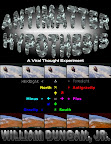But galaxies give birth to black hole litters of dozens, and many black holes grow into healthy galaxies. The continual increase in mass of a growing universe challenges the concept of entropy. In the cyclical cellular cosmological model all the momentum in the universe sums to zero, all the matter and antimatter plus the amount locked in black holes annihilates to zero, what remains is photons that are the antiparticles of themselves. Photons and photon momentum also sum to zero. The universe is a divergent vacuum fluctuation.
So how do black holes generate more output than the amount of their initial mass? Black holes absorb electromagnetic radiation produced by the fusion of stars. In addition to their original mass, black holes tap energy from their surrounding environment and convert that energy into the mass of neutral nucleons: neutrons or antineutrons.
The observed red shift is not only caused by the Doppler Effect, but red shift is also susceptible to Compton scattering and gravitational red shift. Light travels fastest through a vacuum, but intergalactic space contains the remains of countless generations past. This slows down the speed of light in a particle medium, and interactions with particles produce thermal heating and Compton scattering. The cosmic microwave background radiation is blackbody radiation from photon thermal friction.
Galaxies and galaxy clusters act like gravitational lenses that produce gravitational red shifts.
The universe is expanding in the fashion of cellular growth by the repulsion of opposite gravitational forces, but red shifts are inconsistent and inaccurate measurements of expansion rate, time, and distance. Expansion of the universe is governed by fractal cosmology. Clusters bunch together and form extended features like the Great Wall and the Sloan Great Wall that the Big Bang cannot explain.
Take a close look at this composite image of a galaxy cluster. At the center is an elliptical galaxy. Blue represents x-rays, yellow visible, and red radio waves.
Very Large Array Telescope: NRAO, and L. Birzan and team (Ohio University)
Let’s take another look at the electromagnetic spectrum. The conventional interpretation for this image is that color represents temperature. According to the experts, the intergalactic temperature of the blue area is fifty million degrees. That’s hard to believe. The antimatter hypothesis alternate explanation is that the source of the x-rays is gamma rays from the annihilation of particles and antiparticles.
| Electromagnetic Spectrum | ||||||
| Radio | Microwave | Infrared | Visible | Ultraviolet | X-ray | Gamma ray |
Notice that gamma rays have higher energy than x-rays. Energy increases to the right. Photons lose energy through absorption. Compton scattering produces photons from the excess energy that atoms cannot absorb. The absorption spectrum of an atom or molecule is identical to its emission spectrum. This image is consistent with the cyclical cellular cosmological model.
Radio waves, on the lower end of the spectrum, are the least energetic. We agree with the experts that the radio waves are generated by jet particles, but we disagree about the mechanism that produces jets, galaxies, galaxy clusters, and the universe.









No comments:
Post a Comment